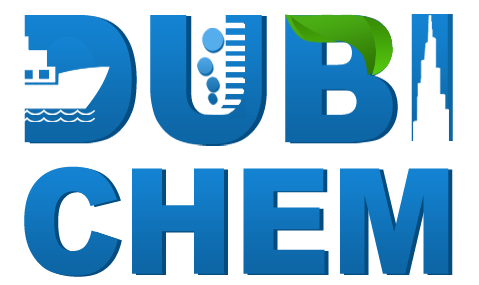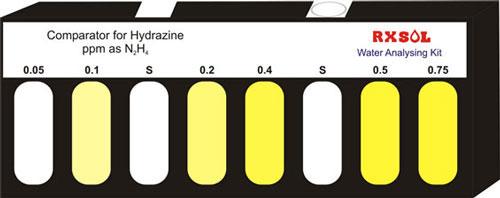Colorimetric Procedure
The objective is to maintain a hydrazine residual between 0.05-0.2 ppm depending on operating pressure and boiler designe. Actual consumption is determined under operating conditions. A normal dosage is approximately 1 ltr. per day, depending of system layout.
Hydrazine is a convenient reductant because the by-products are typically nitrogen gas and water. Thus, it is used as an ANTIOXIDANT, an oxygen scavenger, and a corrosion inhibitor in water boilers and heating systems.
Hydrazine is mainly used as a foaming agent in preparing polymer foams.
No oxygen is entering the boiler with the feed water when hydrazine is present in the water.
Directions for use : Based on Colorimetric Procedure
1. Take 5 ml of sample to be tested in the Test jar ( Before testing, samples must be cooled to 25oC by passing them through a cooler.). if necessary. Turbid samples are to be filtered with a filter paper.
2. Add 40 drop (2ml) of Reagent TK-16. Mix wel
3. Add 2 micro spoon full of Reagent TK-17. Mix well upto provider dissolves Completely. Wait for 10 minutes.
4. Now rinse the empty comparator tube with above solution and will upto the half level of the comparator tube.
5. Insert this tube in sample slot of comparator.
6. Compare the developed colour with standard comparator colours. Slide the comparator until the colors match. Check the mea- surement reading in the recess on the comparator reed. Mid values can be estimated
7. Note down the ppm level of Hydrazine as N2H4
8.After use, rinse out both measuring glasses thoroughly and seal them.
Note 1 ::: Studies showed that hydrazine was not stable on the sampling device, therefore, immediate extraction of samples after collection was recommended.
Note 2 ::: color is stable for 1 hours.
Sample of Hydrazine is Harmful. Handle with due care.
All open chemicals should be used only in a fume hood.
Avoid any skin contact with all chemicals. Immediately flush contaminated areas with copious amounts of water.
Wear safety glasses at all times.
Always try to keep HYDRAZINE level at minimum level. As by the decomposition of hydrazine ammonia will be liberated and Ammonia in the presence of oxygen is corrosive to copper and copper alloys.
It will be necessary to test the hydrazine residuals in the boiler daily in order to obtain complete protection with minimum doses of hydrazine. If the hydrazine residual in the boiler is over 0.1 PPM, reduce the dosage of hydrazine until the boiler hydrazine residual falls below the recommended maximum of 0.1 PPM. If the hydrazine residual does not immediately drop below the 0.1 PPM level, the boiler should be blowdown to reduce the hydrazine level. New boilers, or those recently open for inspection and repair, may take several weeks to achieve a normal boiler hydrazine residual due to oxides. This is normal, and until a hydrazine residual is obtained in the boiler water, test the feed water for the hydrazine content. Maintain the hydrazine reading in the feed water between 0.02 and 0.03 PPM. No oxygen is entering the boiler with the feed water when hydrazine is present in the water. hydrazine may be dosed into the feed pump suction, more preferably, to the storage section of the deaerator, which will maximize the residence and reaction time. A separate dosing tank and pump set should be used for dosing hydrazine to the system. (Condensate Control may be fed with the hydrazine.) The estimated daily dose should be mixed with condensate and the pump should be to deliver the daily dosage over an entire 24 hour period. If a pump and tank set is not available, hydrazine (and Condensate ControL) can be added to the system through a tank and flowmeter into the atmospheric drain tank.
The reagent that is used in this test is corrosive. Use protection for eyes and skin and be prepared to flush any spills with running water.
Wear protective gloves.
IF ON SKIN: Wash with plenty of soap and water.
IF IN EYES: Rinse cautiously with water for several minutes. Remove contact lenses, if present and easy to do. Continue rinsing.
Hydazine Dose Level
|
Low Pressure Boiler ( 0 to 40 bar ) |
0.10 to 0.2 ppm level |
|
Medium Pressure Boiler ( 41 to 60 bar ) |
0.1 to 0.15 ppm level |
|
High Pressure Boiler ( more then 60 bar) |
0.05 to 0.10 ppm level |
Before Sampling all PRECAUTION should be taken :::
Toxic effects of Hydrazine ( which is collected in sample ) is a severe skin and mucous membrane irritant in humans; in animals.In humans, the vapor is immediately irritating to the nose and throat and causes dizziness and nausea; itching, burning, and swelling of the eyes develop over a period of several hours. Severe exposures of the eyes to the vapors causes temporary blindness lasting for about 24 hours. Recurrent exposure to hydrazine hydrate has been reported to cause contact dermatitis of the hands without systemic intoxication. In humans, hydrazine is absorbed through the skin, by inhalation, and orally; systemic effects include weight loss, weakness, vomiting, excited behavior, and convulsions; the chief histologic findings are fatty degeneration of the liver and nephritis.
|
Interfering Substance |
Interference Level |
|
Ammonia |
No interference up to 10 mg/L. May cause a positive interference of up to 20% at 20 mg/L. |
|
Highly colored or turbid samples |
Prepare a 1:1 mixture of deionized water and household bleach. Add one drop of this mixture to 25 mL of sample in a graduated mixing cylinder and invert to mix. This will destroy any hydrazine in the sample. Use this solution, instead of deionized water, to prepare the blank in the test procedure.
|
| Morpholine | No interference up to 10 mg/L. |
Accuracy Test :
Standard solution method
Use the standard solution method to validate the test procedure, the reagents and the instrument. Items to collect:
1. Hydrazine sulfate, reagent grade
2. 1-L volumetric flask, Class A (2)
3. 10-mL volumetric pipet, Class A and pipet filler
4. Deionized water, oxygen-free
Preparation Method :
Prepare a 25-mg/L hydrazine stock solution as follows:
Add 0.1016 g of hydrazine sulfate into a 1-L volumetric flask. Dilute to the mark with oxygen-free deionized water (heat water to boiling and cool). Mix well. Prepare the stock solution each day.
Prepare a 0.25-mg/L (250-μg/L) hydrazine standard solution as follows:
Use a pipet to add 10.00 mL of the 25-mg/L hydrazine stock solution into a 1-L volumetric flask.
Dilute to the mark with oxygen-free deionized water. Mix well. Prepare the standard solution immediately before use.
Use the test procedure to measure the concentration of the prepared standard solution.
Compare the expected result to the actual result.
Note: The factory calibration can be adjusted slightly with the standard adjust option so that the instrument shows the expected value of the standard solution. The adjusted calibration is then used for all test results. This adjustment can increase the test accuracy when there are slight variations in the reagents or instruments.
PRINCIPLE of Hydrazine TEST for Boiler water and Water:::
Under acidic conditions, hydrazine combines with Hydrazine Test Reagent TK - 17 to form a yellow- colored complex. Color development follows and is stable after maximum color is developed in 10 to 15 minutes.
Where Hydrazine Test Kit used ?
HYDRAZINE TEST KIT is used for the determination of Hydrazine content in the Boiler’s Water. The test must be performed when in the vessel’s Boiler Water Treatment used hydrazine ingredient to control rust and corrosion RXSOL-50-5022-025 / RXSOL-50-5007-025 / RXSOL-19-1541-025. This is an activated hydrazine solution (Hydrazine with a catalyst for faster reaction with Dissolved Oxygen,) and applied for marine and industrial Boilers in low, medium and high pressures.
Benefit of Hydrazine Test Kit ?
Following the procedure above, the concentration in ppm of Hydrazine in the Boiler Water will be obtained. According to the Boiler’s working conditions, and the results obtained the dosage of Oxygen Scavenger / Hydrazine must be adjusted considering the dose chart. For effective boiler water treatment with Hydrazine and in order to avoid any problem of Oxygen corrosion, the test at the initial period of use of RXSOL Oxygen Scavenger must be performed every day. Once a small concentration of Hydrazine obtained in the Boiler water then the test could be repeated every 2–3 days.
Limitation of Hydrazine Dose ?
Control of Hydarazine level in Boiler water is very important. As proper level maintenance protect metal machinery parts from corrosion, However, precautions must be taken to prevent excess dose of hydrazine chemical as excess hydrazine will begin to decompose at temperature above 200oC to form Ammonia.
Hydrazine is one of popular an alternative Oxygen Scavenger. It is very important to protect boiler components from feed boiler water corrosion.

